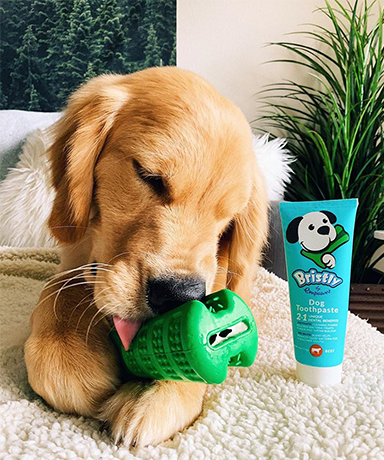Your Cart is Empty

Time to make your inbox pawsome
Sign up today and get 10% OFF your first purchase!


Dog’s simply love to chew. However, with so many options out there it can be hard to determine which type of chew toy is best for you pup. Let’s take a look at the most popular types of bones and chew toys.
In the wild, you would expect your dog to eat the bones of the animals it kills, right? So, why would a domestic dog have different instincts? Raw bones are simply the bones from other animals that are raw in their form, meaning not cooked. There are nutritional benefits to eating raw bones, like getting magnesium and calcium from the bone itself, protein from any meat leftover on the bone, as well as nutritionally dense marrow inside the bone. In addition, there are also dental health benefits when your dog chews raw bones.
Chewing bones in their natural state can encourage healthy teeth and gum development. The act of chewing can help brush away plaque that builds up on your dog's teeth, making their chances of periodontal disease decrease.
Warning: it is not recommended to let your dog chew on bones that have been cooked. Cooking bones can make them more susceptible to breaking and splintering, causing pieces to get lodged in your dog's throat, or stuck in their intestines or stomach, where they may tear the internal lining.
With any type of raw bone, you run the risk of splintering. These bones can break apart and get lodged in your dog’s throat or intestines. While many people swear by the raw dog diet or giving them raw bones, it’s important to do your research and talk with your vet.
You may be hesitant to get plastic bones for your dog because you have heard some unpleasant facts about them. We'll try to clear that up right now: plastic bones are made for your dog to chew on,but not to consume.
Plastic bones such as Nylabones are regarded as dangerous to dogs because shards of the bone will start to splinter and break away from the bone, leaving bite-sized pieces to eat, or the dog may just tear pieces off and ingest them. That is when these types of bones become dangerous.
The process of chewing is actually beneficial for dog oral health. As stated above, chewing on bones can reduce plaque and tartar buildup in your dog's mouth, which can be very positive in maintaining your dog's dental health. A
Although it is recommended that you brush your dog's teeth semi-regularly, giving your dog bones in between brushings can reduce boredom and actually improve your dog's dental health. If you do choose to give your dog a plastic bone, keep an eye on him and if it starts to become a snack instead of a chew toy, throw it away.
Rawhide is the inner layer of cowhides and it is shaped and processed in a way to turn it into a chew toy for dogs. Like Nylabones, some pet owners approach rawhides with anxiety because of the way they are produced. Degreasers and detergents laden with chemicals have been known to be used in the production of rawhides, and although they are thoroughly rinsed before selling, this can still be met with some unease.
If you're comfortable with giving your dog a rawhide it can be beneficial to their oral health, as has been stated before, just because it gives them something to chew on. Make sure to routinely inspect your dog's mouth to make sure they're not chipping any teeth or chewing so vigorously they're scratching their gums or the inside of their mouth.
Another risk to be careful of with rawhides - if your dog has a tendency to rip bones or toys apart in order to ingest them, you may want to rethink giving them a rawhide. While small pieces can probably be dissolved in your pooch's stomach acid, big portions, if they make it past the stomach, can get lodged inside your dog's intestines.
Rubber toys are becoming more popular because they don’t break off into hard pieces that can harm the dog. However, it’s important to know what ingredients are in the material so that you know whether or not it’s safe.
Rubber bones and dog toys should not break apart. While like all dog toys, you will experience some pieces coming off from excessive chewing, they should never split in half or into large pieces.
Depending on your dog’s rubber toy, these are usually the safest, especially if made with a rubber that holds strong. When it comes to their dental health, it’s typically better to get rubber toys that have grooves in them, since smooth rubber will not be as effective at getting rid of plaque and tartar.
As you may know, chewing is a natural and instinctual behavior for dogs. It’s rare to find a dog, especially a young dog who doesn’t like to chew. One of the most significant benefits of chewing for dogs is that it can help them keep their mouth clean by scraping away plaque and tartar.
We took a look at dogs' natural urge to chew and the dental health benefits to create Bristly, a dog DIY toothbrush created with dog anatomy in mind. For just five minutes a day, your pup will brush and play the plaque away for fresher breath and a healthier mouth.
